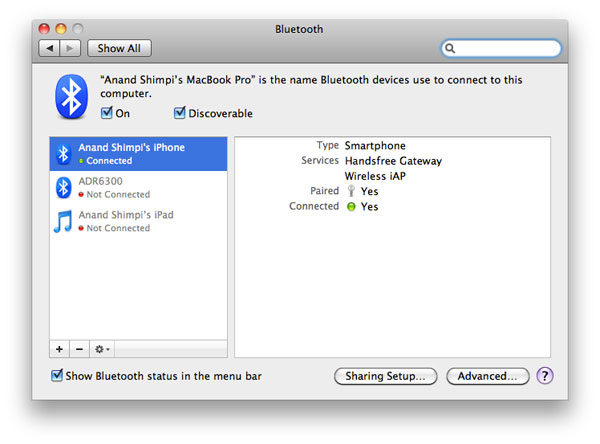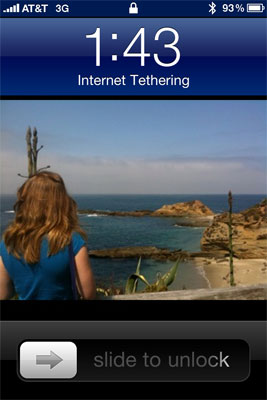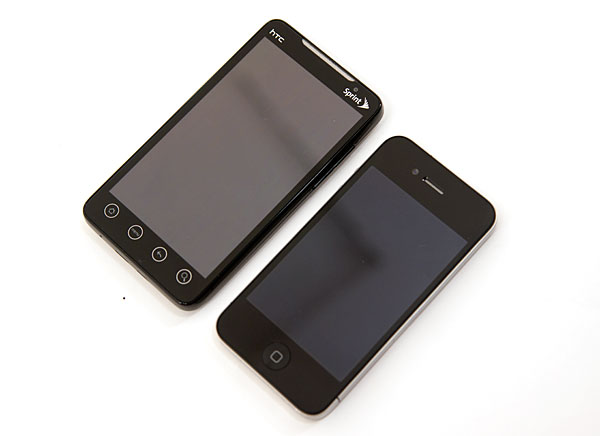Apple's iPhone 4: Thoroughly Reviewed
by Brian Klug & Anand Lal Shimpi on June 30, 2010 4:06 AM EST- Posted in
- Smartphones
- Apple
- iPhone 4
- Gadgets
- Mobile
Living with the 4
Thus far the majority of this article has focused on the technical details of the new iPhone both in its advancements and shortcomings, but what is it like to live with?
As I implied in the introduction, the 4 makes the previous iPhone feel very old. But in day to day use it doesn’t feel much different. It uses the same iOS that iPhone 3GS users get access to so with the exception of FaceTime and camera improvements, the iPhone 4 is functionally the same as its predecessor. That’s an important thing to keep in mind because to a 3GS owner it makes the iPhone not feel any different.

We've already covered iOS 4 extensively so there's no point in rehashing that here. The only new experience we have to add is our time with tethering.
The option to enable tethering is unfortunately buried in iOS 4's settings. You need to go into general settings, then network and then Internet tethering. You also need to either have Bluetooth enabled or be connected via USB to the computer you wish to tether.

You of course need to have tethering enabled on your plan, which you can't do from the settings menu. You either have to call AT&T or add the plan via attwireless.com. From there just connect to the 4 and you can use it as a modem. The phone can even be locked while tethered. Once enabled it ranges from a lifesaver to a total waste of money depending on AT&Ts coverage.

Getting used to the size of the new iPhone isn't hard at all. The device is a lot thinner which makes two handed portrait operation more strenuous especially if you're typing a lot on it. The 4 is going to be one great gaming device because holding it in landscape mode feels awesome. Overall I'd say the size feels right.
The glass everywhere is nice. It does make it impossible to quickly tell which side is front when you're fumbling around your pocket looking for it though. And I still feel like I'm going to drop and break the thing in no time at all. While not as slick as the 3GS' plastic, the stainless steel and glass aren't exactly the most grippy surfaces.
The higher res screen makes even sending text messages clearer. Everything is just so much more crisp.

Browsing the web is more pleasant as well, but tiny text is still tiny text regardless of how sharp the display is. You'll still need to zoom in on regular sites.
You do get used to the screen though. It's only when going back to the 3GS that the 4 feels new again. It's sort of like an SSD, you miss the retina display when it's gone.
The seat of the pants feel has definitely improved thanks to the A4. Although, I'd say its subtle. Web pages load quicker, animations are smoother. It's not perfect however. There are still some choppy animations and pauses from the scheduler giving too much CPU time to a hungry process. In general though, the phone feels like it was designed to run iOS 4 while the 3GS can get a bit overwhelmed at times.

The OS improvements, although not specific to the 4, are still lacking in two key areas. Apple still hasn't implemented a good notification system ala Android or webOS. I expected that update with iOS 4 but I guess we'll get it next year instead.
Secondly the multitasking interface is nice but still not quite perfect. I am still holding out for either an improved webOS or for Apple to do it's own take on the card system.
How does the 4 compare to Android? The same differences are still there. Currently there is no Android phone quite as sleek as the iPhone 4, although I expect that could change in less than a year.
The latest Android phones have had better cameras and higher resolution screens, so the iPhone 4 doesn't have as huge of an advantage there.
Apple still has the UI polish down pat. Scrolling is far smoother and performance more consistent, although I believe Google isn't far away from fixing this. The Froyo update alone does wonders to performance. If Google could fix the scrolling issues I'd say a number of iPhone users would for sure be fine with switching.

There is this more open, more configurable, more capable feel you get with Android that you don't with the iPhone. That can be both a positive and a negative. Android phones feel more like computers while iPhones have more of that appliance feel. It still boils down to personal preference, the 4 won't change that.










270 Comments
View All Comments
Griswold - Wednesday, June 30, 2010 - link
Lets be honest, he has only very limited means to meassure the problem. To get to the bottom of this, it needs to be meassured in a HF lab.samspqr - Wednesday, June 30, 2010 - link
"The fact that Apple didn't have the foresight to coat the stainless steel antenna band with even a fraction of an ounce worth of non-conductive material either tells us that Apple doesn't care or that it simply doesn't test thoroughly enough."I find it really funny that they would never catch this specific problem because of them just being apple: if their engineers are not as good as anand is (as in thinking "that's gonna be a problem" right after hearing the description of the antenna), and if THE FIELD TESTERS HAD THEIR PHONES DRESSED AS A 3GS BECAUSE OF PARANOID ISSUES, this kind of problem can only slip through
The0ne - Wednesday, June 30, 2010 - link
I think Anand was a little light on this topic. As an multi-discipline engineer myself this type of problem with the Antenna SHOULD NEVER had happened. It can only happened due to decisions that did not properly address it. This is not rocket science to engineers. If anything, testing WOULD HAVE discover the problem and yet it's in the finish product. Quite sad if you ask me.For example, why put a ferrite clamp on the end of the cable instead of designing it into the PCB . The only reason I can see why we did this was due to lack of time and we severely paid for it by having products become defective because the ferrite would pull the cables loose from the connectors.
deppbv78 - Wednesday, June 30, 2010 - link
I'm really disappointed at the lengths taken by AT to justify that iP4 losing signal as not a big deal...If it was any other product from any other manufacturer, I'm sure you'd not have gone to such lengths to justify the signal drop and just concluded that the phone has serious antenna problems. I'm not understanding why is it so difficult for anyone just provide an unbiased view of the product.I have HTC Hero & Touch Pro both of which lost a bar or two (with fluctuations) when cupped tightly. However, it was always just 1-2 bars and never went down like iPhone 4 does from 5 bars to 0. This continuous loss of signal is the problem. Justifying it telling that all phones lose signal is not right, as every other phone (including 3GS) loses signal temporarily and then stabilizes unlike iPhone 4.
No wonder the iPhone 4 is engineering marvel, but that set aside it is also true that the design has created issues as well and the reviews need to acknowledge it and not justify it
geniekid - Wednesday, June 30, 2010 - link
HTC Incredible owner here. I think AT successfully showed that the antenna issue is NOT a big deal and their methods for doing so are sound. I share your suspicion that maybe they wouldn't have made such a significant investigation if it had been another phone, but let's not accuse them of mistakes they haven't made yet.bplewis24 - Wednesday, June 30, 2010 - link
I have a sincere question though. Does this test really successfully show the antenna issue is NOT a big deal, or does it simply show that it's not a big deal in the utmost ideal conditions?Sometimes the article is difficult to decipher in terms of understanding who is saying what, but upon my initial reading I take it Brian did the testing of the antenna in Arizona. By his own admission (from my understanding), he lives there because the reception is absolutely stellar and about as good as it can possibly be.
Again, from what I can tell, it is under those conditions that he conducted the attenuation signal loss comparisons. If it still drops down to 1 bar and comes reasonably close to dropping calls under the best possible conditions, how does it react under "average" conditions? Other people are reporting dropped calls for a reason. Is Brian's test the norm or an outlier?
Please correct me if I've read this article wrong.
Brandon
anactoraaron - Wednesday, June 30, 2010 - link
My understanding is you are partially correct in assuming (which is what I interpreted from your post) that under "normal" or "average" conditions you will go to one bar - which with the improved reception even at 1 bar you are still fine - OR will drop signal completely.This is also the reason why they say "At the bare minimum Apple should give away its bumper case with every iPhone 4 sold."
Again, fantastic in-depth review.
strikeback03 - Thursday, July 1, 2010 - link
Well, he said the location he lives in has stellar reception. But he also said he drove around for a day testing, which implies to me that he found somewhere with a stable, "average" signal and did some testing there, then probably went somewhere with a "poor" signal and did some more, etc.bplewis24 - Friday, July 2, 2010 - link
@strikeback03Correct. And in driving around to the less-than-stellar areas showed the phone dropping down below -107dB for reception when showing less than 2 bars. And this is on the low end of the reception spectrum as described earlier in the article. So it's pretty clear that the antenna does INDEED show poor signal strength in average or less than average areas when the "death grip" is applied.
That is the determining factor. That determines that the design is defective and flawed. If it was not designed that way, when in average or below signal areas, the reception would still be average or below, and not well below because of the way you hold the phone.
However, the article skirts this and attempts to present it in a way that shines the best possible light on Apple and their defective design. Big disappointment in terms of an objective review.
Brandon
geniekid - Wednesday, June 30, 2010 - link
The article made it clear that bars are a misleading way of measuring call quality/reception. In practice, it was noted that call quality/reception is improved/equal to the 3GS on the 4, regardless of bars (raw signal power).Who cares if you have 1 bar all the time if you're still making calls better than someone with 4 bars?
HTC Incredible owner here.